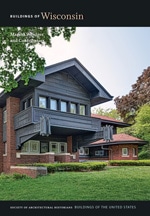
In the immediate aftermath of World War II, returning veterans, using the GI Bill’s generous educational benefits, swelled Stout State College’s student population and created a severe local housing shortage. To house them, Menomonie, like many other college towns, built prefabricated houses. In 1946, the Menomonie Housing Authority bought at least twenty prefab dwellings from the Gamble-Skogmo Company, a retail chain in Minneapolis that normally specialized in auto parts, appliances, hardware, and paint. Because of the continuing materials shortage immediately after the war, these were often the only houses available.
The dwellings resembled the temporary Quonset huts that the military had erected during the war for barracks, hospitals, and other uses. Semicylindrical corrugated steel roofs, riveted to arched steel ribs, made Quonsets look like giant steel cans split lengthwise and laid on the ground. Manufactured by Great Lakes Steel, Quonsets got their name from the Rhode Island naval station where navy designers developed the prototype. After the war, magazines suggested ways to make Quonsets into homelike residences, and Great Lakes Steel, through its Stran-Steel subsidiary, introduced inexpensive Quonset-style houses.
The designer of the Gamble-Skogmo prefabs modified the Quonset form to impart coziness. Some roofs are slightly pointed instead of rounded at the apex, so they resemble conventional gables. Also, the roofs are shingled above, and the siding below is wood, not corrugated steel. Each house has a front-facing central entrance pavilion with a door and flanking windows. The flat-walled pavilion projects from the receding curve of the roof, much like a wall dormer, and it bears a pent roof so that from the street it looks like a side-gabled form.
Similar examples of prefabricated houses can be seen in Sturtevant (9706 and 9710 Corliss Avenue and 2840, 2846, and 2848 97th Street) and River Falls (503 and 509 Lewis Street). Others made of metal survive in Green Bay (905 and 907 12th Avenue).








